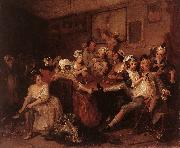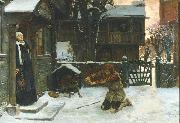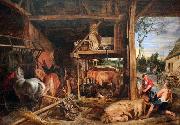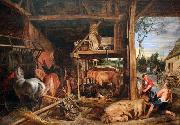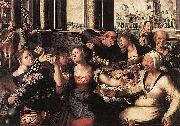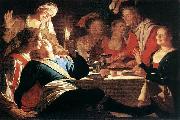Wholesale Oil Painting No Minimum |
|||||||||||
|
|
|||||||||||

|
|||||||||||
|
|
|
||||||||
HOGARTH, WilliamBritish Painter and Printmaker, 1697-1764 English painter and engraver. He played a crucial part in establishing an English school of painting, both through the quality of his painting and through campaigns to improve the status of the artist in England. He also demonstrated that artists could become independent of wealthy patrons by publishing engravings after their own paintings. |
||||||||
|
|
||||||||
The Prodigal Son
The Prodigal Son Painting ID:: 32350 |
c. 1735
Oil on canvas, 62,5 x 75 cm c. 1735 Oil on canvas, 62,5 x 75 cm |
|||||||
|
|
||||||||
georg von rosenJohan Georg Otto von Rosen, född 13 februari 1843 i Paris, död 1923 i Stockholm, var en svensk konstnär och greve av ätten von Rosen. Han målade i den akademiska stilen, till stor del historiemåleri och porträtt. Han var professor vid Konstakademien 1880-1908 och dess direktör 1881-1887 samt 1893-1899. Som konstakademiens direktör kom han i stark konflikt med den nya generation av konstnärer som krävde reformer av akademiens utbildning och utställningsverksamhet, de så kallade opponenterna. Georg von Rosen föddes i Paris 1843 som son till generalkonsuln greve Adolf Eugene von Rosen (kallad "de svenska järnvägarnas fader") och hans hustru Euphrosyne Rizo-Rangabe. Hans första levnadsår förflöt i Paris, varifrån familjen flydde till Sverige under februarirevolutionen 1848. Han studerade 1855-1861 vid Konstakademien i Stockholm. 1862 besökte Rosen världsutställningen i London där han lärde känna belgaren Henri Leys' arbeten, målningar med scener från medeltiden och renässansen målade i ålderdomlig stil. Dessa verk gjorde ett stort intryck på von Rosen. Han skrev själv Stående hvarje dag i flere timmar, försjunken i åskådandet af dessa om en snart sagdt öfvermänsklig intuition vittnande bilder, som likväl flertalet i den stora hopen med likgiltighet skred förbi, drömde jag mig tillbaka in i en hänsvunnen tid och för mina yttre ögon försvann hela den öfriga utställningen, den omgifvande mängden, ja hela den existerande verlden! Då jag lemnade London, var jag på 14 dagar vorden 300 år äldre. Rosen uppsökte följande året mästaren i Antwerpen och tillbringade en tid i hans umgänge och i hans atelje. Återkommen till Sverige, inspirerad av mötet, målade han Sten Sture d.ä. intåg i Stockholm. Den medeltida stadsmiljön med det noggranna återgivandet av stenläggningen och den närmast osannolika rikedomen på byggnadsdetaljer känns igen från Leys målningar. von Rosen belönades med kunglig medalj för målningen, och blev hyllad och uppskattad av Oscar II på grund av bildspråket, som i hög grad uttryckte den oscarianska epokens ideal. Samma år begav han sig ut på resa och besökte Egypten, Palestina, Syrien, Osmanska riket, Grekland och Ungern där han studerade måleri. 1866 vistades han ett år i Rom och vistades sedan åter hos Leys fram till dennes död 1869. Därefter studerade han i Menchen under Karl Piloty och reste sedan vidare till Italien innan han återkom till Sverige 1871. Efter hemkomsten målade han Erik XIV och Karin Månsdotter. 1872 blev han ledamot av Konstakademien, 1874 blev han vice professor, 1879 kammarherre och 1880 professor i figurteckning och målning. 1881-1887 samt 1893-1899 var han direktör för Akademins läroverk. 1892-1900 var han även ordförande i Nordiska samfundet till bekämpande av det vetenskapliga djurplågeriet, numera Djurens Rätt. Han avled 1923 och förblev ogift under hela sitt liv. |
||||||||
|
|
||||||||
|
|
The Prodigal Son
The Prodigal Son Painting ID:: 68682 |
1885(1885)
Olja på duk
140 X 198 cm (55.12 X 77.95 in)
1885(1885) Olja på duk 140 X 198 cm (55.12 X 77.95 in) |
||||||
|
|
||||||||
Peter Paul RubensFlemish Baroque Era Painter, 1577-1640 Peter Paul Rubens (June 28, 1577 ?C May 30, 1640) was a prolific seventeenth-century Flemish Baroque painter, and a proponent of an exuberant Baroque style that emphasized movement, color, and sensuality. He is well-known for his Counter-Reformation altarpieces, portraits, landscapes, and history paintings of mythological and allegorical subjects. In addition to running a large studio in Antwerp which produced paintings popular with nobility and art collectors throughout Europe, Rubens was a classically-educated humanist scholar, art collector, and diplomat who was knighted by both Philip IV, king of Spain, and Charles I, king of England. Rubens was a prolific artist. His commissioned works were mostly religious subjects, "history" paintings, which included mythological subjects, and hunt scenes. He painted portraits, especially of friends, and self-portraits, and in later life painted several landscapes. Rubens designed tapestries and prints, as well as his own house. He also oversaw the ephemeral decorations of the Joyous Entry into Antwerp by the Cardinal-Infante Ferdinand in 1635. His drawings are mostly extremely forceful but not detailed; he also made great use of oil sketches as preparatory studies. He was one of the last major artists to make consistent use of wooden panels as a support medium, even for very large works, but he used canvas as well, especially when the work needed to be sent a long distance. For altarpieces he sometimes painted on slate to reduce reflection problems. His fondness of painting full-figured women gave rise to the terms 'Rubensian' or 'Rubenesque' for plus-sized women. The term 'Rubensiaans' is also commonly used in Dutch to denote such women. |
||||||||
|
|
||||||||
|
|
The Prodigal Son
The Prodigal Son Painting ID:: 81326 |
Date ca. 1618(1618)
Medium Oil on wood
Dimensions 107 x 155 cm (42.1 x 61 in)
Date ca. 1618(1618) Medium Oil on wood Dimensions 107 x 155 cm (42.1 x 61 in) |
||||||
|
|
||||||||
Peter Paul RubensFlemish Baroque Era Painter, 1577-1640 Peter Paul Rubens (June 28, 1577 ?C May 30, 1640) was a prolific seventeenth-century Flemish Baroque painter, and a proponent of an exuberant Baroque style that emphasized movement, color, and sensuality. He is well-known for his Counter-Reformation altarpieces, portraits, landscapes, and history paintings of mythological and allegorical subjects. In addition to running a large studio in Antwerp which produced paintings popular with nobility and art collectors throughout Europe, Rubens was a classically-educated humanist scholar, art collector, and diplomat who was knighted by both Philip IV, king of Spain, and Charles I, king of England. Rubens was a prolific artist. His commissioned works were mostly religious subjects, "history" paintings, which included mythological subjects, and hunt scenes. He painted portraits, especially of friends, and self-portraits, and in later life painted several landscapes. Rubens designed tapestries and prints, as well as his own house. He also oversaw the ephemeral decorations of the Joyous Entry into Antwerp by the Cardinal-Infante Ferdinand in 1635. His drawings are mostly extremely forceful but not detailed; he also made great use of oil sketches as preparatory studies. He was one of the last major artists to make consistent use of wooden panels as a support medium, even for very large works, but he used canvas as well, especially when the work needed to be sent a long distance. For altarpieces he sometimes painted on slate to reduce reflection problems. His fondness of painting full-figured women gave rise to the terms 'Rubensian' or 'Rubenesque' for plus-sized women. The term 'Rubensiaans' is also commonly used in Dutch to denote such women. |
||||||||
|
|
||||||||
|
|
The Prodigal Son
The Prodigal Son Painting ID:: 85366 |
. 1618(1618)
Medium Oil on wood
Dimensions 107 x 155 cm (42.1 x 61 in)
cyf . 1618(1618) Medium Oil on wood Dimensions 107 x 155 cm (42.1 x 61 in) cyf |
||||||
|
|
||||||||
Jan van Hemessen(c. 1500 - c. 1566) was a Flemish Northern Renaissance painter. He was born in Hemiksem, then called Hemessen or Heymissen. Following studies in Italy, in 1524 he settled in Antwerp. A mannerist, his images focused on human failings such as greed and vanity. Like his daughter, Catarina van Hemessen,he specialised in painted portraits. Jan Sanders van Hemessen was a Flemish Northern Renaissance painter who was part of the mannerist movement. He was born in Hemessen in the Netherlands but settled in Antwerp in 1524 after studying in Italy. Hemessen specialized in scenes of human character flaws such as vanity and greed. His pictures are often religious, while his style helped found the Flemish traditions of genre painting. Hemessen was also a portrait painter, which influenced his daughter to become a Flemish Northern Renaissance painter as well. The Surgeon of 1555 is an oil painting by Jan Sanders Van Hemessen currently in the Museo del Prado in Madrid, Spain. The scene likely represents a stonecutter at a fair. The surgeon, who is clearly happy that his operations have been successful, painstakingly moves his knife towards the stone, which is already visible. Behind him hang stones which have been successfully cut out of the head of other patients as a sign of his skill. Next to the quack stands a man who is wringing his hands in desperation, clearly going to be the next patient under the scalpel. |
||||||||
|
|
||||||||
|
|
The Prodigal Son
The Prodigal Son Painting ID:: 89144 |
1536(1536)
Medium oil on oak
cyf 1536(1536) Medium oil on oak cyf |
||||||
|
|
||||||||
Gerard van Honthorst(November 4, 1592 - April 27, 1656), also known as Gerrit van Honthorst and Gherardo della Notte, was a Dutch painter of Utrecht. He was brought up at the school of Abraham Bloemaert, who exchanged the style of the Franckens for that of the pseudo-Italians at the beginning of the 16th century. Margareta Maria de Roodere and Her Parents by Gerrit van Honthorst (1652) Oil on canvas, 140 x 170 cm. Centraal Museum, UtrechtInfected thus early with a mania which came to be very general in the Netherlands, Honthorst went to Italy in 1616, where he copied the naturalism and eccentricities of Michelangelo da Caravaggio. Home again about 1620, after acquiring a considerable practice in Rome, he set up a school at Utrecht which flourished exceedingly. Together with his colleague Hendrick ter Brugghen, he represented the so-called Dutch Caravaggisti. In 1623 he was president of his gild at Utrecht, where he had married his cousin. He soon became so fashionable that Sir Dudley Carleton, then English envoy at The Hague, recommended his works to the earl of Arundel and Lord Dorchester. In 1626 he received a visit from Rubens, whom he painted as the honest man sought for and found by Diogenes. |
||||||||
|
|
||||||||
|
|
The Prodigal Son
The Prodigal Son Painting ID:: 89785 |
1622(1622)
Medium oil on panel
cyf 1622(1622) Medium oil on panel cyf |
||||||
|
|
||||||||
|
Gerard van Honthorst (November 4, 1592 - April 27, 1656), also known as Gerrit van Honthorst and Gherardo della Notte, was a Dutch painter of Utrecht. He was brought up at the school of Abraham Bloemaert, who exchanged the style of the Franckens for that of the pseudo-Italians at the beginning of the 16th century. Margareta Maria de Roodere and Her Parents by Gerrit van Honthorst (1652) Oil on canvas, 140 x 170 cm. Centraal Museum, UtrechtInfected thus early with a mania which came to be very general in the Netherlands, Honthorst went to Italy in 1616, where he copied the naturalism and eccentricities of Michelangelo da Caravaggio. Home again about 1620, after acquiring a considerable practice in Rome, he set up a school at Utrecht which flourished exceedingly. Together with his colleague Hendrick ter Brugghen, he represented the so-called Dutch Caravaggisti. In 1623 he was president of his gild at Utrecht, where he had married his cousin. He soon became so fashionable that Sir Dudley Carleton, then English envoy at The Hague, recommended his works to the earl of Arundel and Lord Dorchester. In 1626 he received a visit from Rubens, whom he painted as the honest man sought for and found by Diogenes. The Prodigal Son 1622(1622) Medium oil on panel cyf |
||||||||
|
|
||||||||
|
Prev Next
|
||||||||
|
|
||||||||
|
Related Paintings to Gerard van Honthorst :. |
||||||||
|
|
||||||||
|
CONTACT US |
